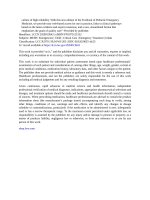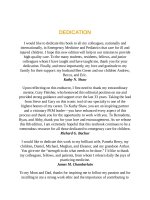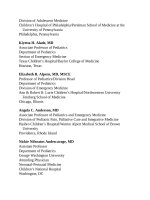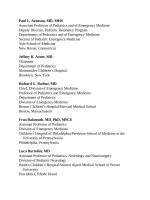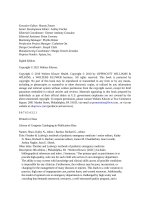Pediatric emergency medicine trisk 0833 0833
Bạn đang xem bản rút gọn của tài liệu. Xem và tải ngay bản đầy đủ của tài liệu tại đây (128.99 KB, 1 trang )
TABLE 41.3
CRITERIA FOR DISCHARGE WITH HOME OBSERVATION
Traumatic force not life threatening
Glasgow Coma Scale score of 15
Nonfocal neurologic examination
No significant symptoms
No history of prolonged loss of consciousness (or normal CT if it did occur)
No intracranial abnormalities on CT (if obtained)
Reliable caregivers who are able to return, if necessary
No suspicion of abuse or neglect
CT, computed tomography.
Most children presenting to the ED after blunt head trauma will not require
advanced imaging or observation. These remaining children, who sustained
impact of minor force, had no LOC, and are alert and asymptomatic with normal
examinations, likely have only minor head trauma with or without extracranial
injuries, including contusions and lacerations. Home observation is appropriate
management for the majority of these patients. Rarely, intracranial complications
develop in these children, causing symptoms hours after the traumatic event;
therefore, the caregiver should be given a printed list of signs and symptoms
(reviewed verbally by the clinician) indicative of increased ICP with instructions
to check the child at regular intervals and to return to the ED if symptoms occur.
Postconcussive counseling (especially with regard to return to sports), when
indicated, should also be given. The caregivers must be reliable and able to return
with the child if necessary, and there must be no suspicion of abuse or neglect—
otherwise admission for observation in the hospital should be considered ( Table
41.3 ).
Suggested Readings and Key References
Babl FE, Borland ML, Kochar A, et al. Accuracy of PECARN, CATCH, and
CHALICE head injury decision rules in children: a prospective cohort study.
Lancet 2017;389:2393–2402.
Badawy MK, Dayan PS, Tunik MG, et al. Prevalence of brain injuries and
recurrence of seizures in children with posttraumatic seizures. Acad Emerg
Med 2017;24(5):595–605.
